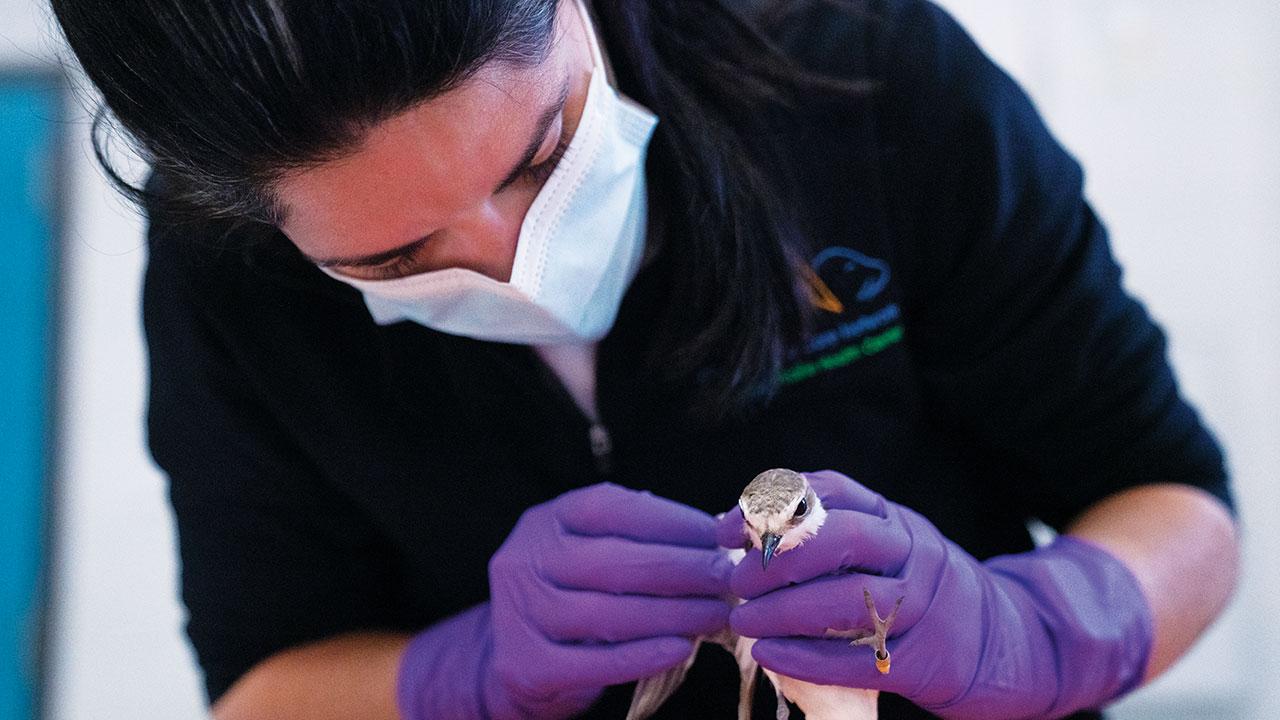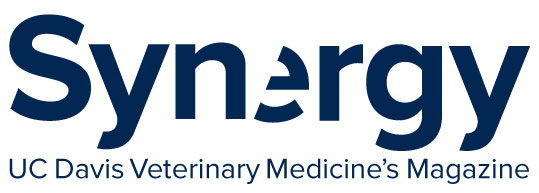
Year in the Life
Rescuing Oiled Wildlife
For more than a decade, Dr. Jamie Sherman ’19 has had a hand in working with bears—including those rescued from wildfires and in need of rehabilitation with the California Department of Fish and Wildlife (CDFW). And when there is the inevitable summer story on how to behave in bear territory when you’re hiking, Sherman is a go-to media spokesperson.
So, when Sherman joined the Oiled Wildlife Care Network (OWCN) under the auspices of the school’s One Health Institute as an oil spill response care veterinarian in 2021, it was a bit of a shift from working with large carnivores. But she says the opportunity allows her to expand her passion for all wildlife species and have an impact on improving care for greater survival success once they are released.
“This position has opened up a new world of species I may not have worked with otherwise,” Sherman said. “And I got to come back home to UC Davis—a great place to combine research with veterinary practice —where it’s an honor to work alongside my previous mentors, now as a peer.”
As one of two OWCN clinical veterinarians, part of Sherman’s role is handling care operations for animals (often shorebirds) impacted by oil spills once they have been triaged at a field stabilization site and deemed stable enough to transfer to a long-term care facility. Once the animals have had a chance to decompress and recover a bit, Sherman examines them thoroughly.
On “intake,” the animals receive hydration, nutrition and any medical treatments they may need (for skin burns, wounds, parasites, etc.) based on their physical exam. From there, they move to a “pre-wash care” phase where they continue to receive those treatments (as most of them are dehydrated and emaciated) so that they are stable for the wash process to remove oil from their feathers (or fur). After wash, they go through the “conditioning” phase where they continue to regain their strength, restore their ability to waterproof their feathers and generally ensure that they are fit enough to successfully return to the wild. Sherman also collects evidence to be used in any potential legal case (oiled feather samples, photos, and a description of the oil distribution and its impact on the animal, for example.)
One of Sherman’s first spill responses was to Huntington Beach last October after an underwater oil pipeline leaked around 25,000 gallons of crude oil into the ocean. Birds were the most impacted, including the western snowy plover, which is listed as federally threatened under the Endangered Species Act and considered a “species of special concern” in California.

“The job can be stressful and emotionally taxing,” Sherman said. “You see these animals and they are hurt, scared and weak. We have to make hard decisions sometimes and not all of them survive. But when they do, and we get to release them, it’s a reminder of why we do this work.”
Sherman stayed in Orange County for six weeks, helping to lead the OWCN response based out of the Los Angeles Oiled Bird Care and Education Center in San Pedro with the help of member organization colleagues from International Bird Rescue. She emphasized that many things she does during an active spill response aren’t necessarily vet-centric.
“In disaster response, you go where you’re needed,” she said. “We clean cages, prepare food, whatever—it’s teamwork. Everyone has different valuable skills they bring to the table. That really comes into play when responding to a spill during a high-stress situation.”
Sherman said she went into oil spill response with the attitude that member organizations and their staff have a lot to contribute and by empowering them, the care of the animals ultimately benefits.
“The Huntington Beach incident was an incredibly successful response, both in terms of wildlife rehabilitation and partnerships,” Sherman said. “I walked away with a sense of pride in our team, and myself as a true response veterinarian.”
Active oil spill response is a relatively small portion of what Sherman does, however. The larger component of her time is spent training others how to provide care for oiled wildlife. OWCN, founded in 1994, is a now a burgeoning 45-member organization with up to 1,600 pre-trained responders and a dozen facilities throughout the state ready to care for oiled wildlife. It’s a level of preparedness unparalleled in the world and a model for global oil spill response.
As OWCN Director Michael Ziccardi (DVM ’93, MPVM ’94, PhD ’01) has pointed out, for oiled animals, the network can mean the difference between life and death—a distinction that carries extra weight for threatened and endangered species.

“The greatest factor for the survival of oiled animals relates to how quickly we, as wildlife responders, can get out, get animals into our care, and start to reverse the effects of oiling,” he said.
That’s where Sherman comes in. She helps develop training for member organizations to provide a standardized approach to
the command, control, and coordination of emergency response so state and local stakeholders can work together effectively and efficiently. Of course, sitting behind a computer taking or creating online training courses isn’t as fun as being in the field, so Sherman has also taken the ATV and Motorboat Operator Training Courses to safely operate equipment used in oil spill response.
Another of Sherman’s roles is to oversee the Karen C. Drayer Wildlife Health Center veterinary externship for fourth year DVM students who come from across the country. She sees this externship— operated in partnership with the CDFW— as one of the most rewarding parts of her job and ensures the students get a diverse experience in meeting other wildlife veterinarians. They also spend part of their time with the CDFW, take a darting lab, and tour the UC Davis veterinary school and other partner facilities.
“I get to introduce them to other aspects of being a wildlife vet and pay forward the mentorship I received when I was a student,” Sherman said. “One of my mentors and fellow UC Davis DVM alum, Dr. Ben Gonzales ’82 from CDFW, used to tell me... I’m mentoring you— it’s important for you to do the same for the next generation.”
While Sherman finds a deep sense of satisfaction in watching a newly released snowy plover scurry across the sand or a pelican take to the skies, she does admit to missing her work with large carnivores. So, when she has time to volunteer at local zoos or with CDFW, you may find her bandaging the paw of a bear or mountain lion impacted by California wildfires.
“I enjoy getting to work with all wildlife species and asking: what do we know about them, what do we know about their treatments, what don’t we know, and what should we look into in order to better their care long term? When you have your answer, you get to affect how people interact with and treat those animals, and how to improve their survival in the wild.”

